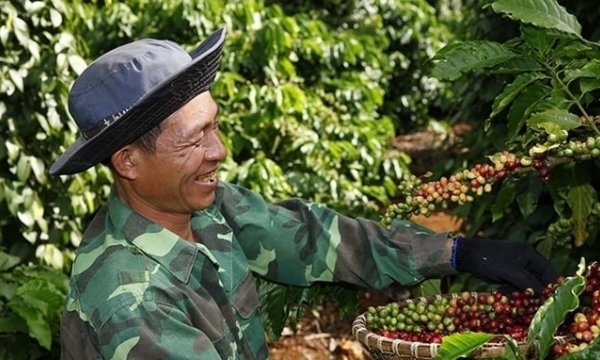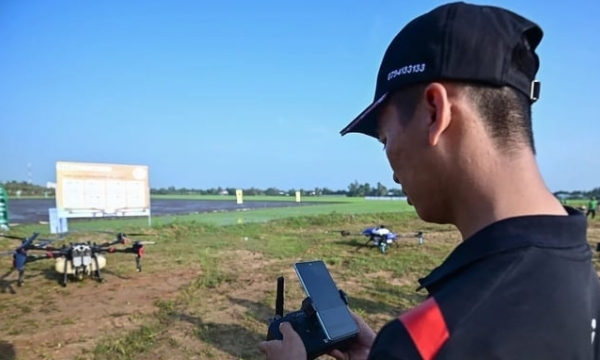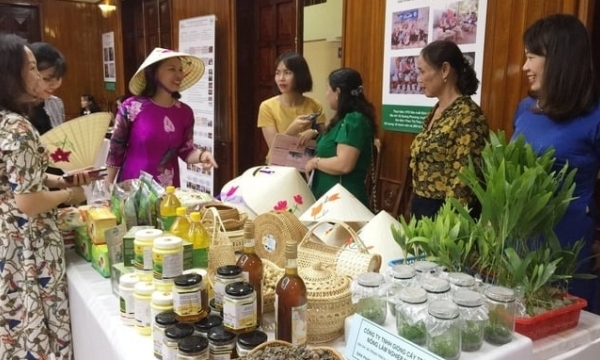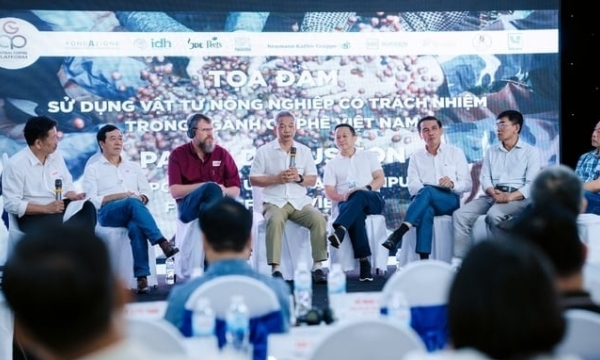May 18, 2024 | 22:38 GMT +7
May 18, 2024 | 22:38 GMT +7
Hotline: 0913.378.918
May 18, 2024 | 22:38 GMT +7
Hotline: 0913.378.918

Dr. Tran Minh Hai, Vice Principal of the School of Public Policy and Rural Development. Photo: Hoang Vu.
That is the sharing of Dr. Tran Minh Hai, Vice Principal of the School of Public Policy and Rural Development, about developing and perfecting the model of building a new agricultural cooperative with Vietnam Agriculture Newspaper.
Collective economics is an inevitable trend in the global economic context and a flat world. As someone who researches policies and supports to promote collective economic development, how do you evaluate the role of cooperatives today, especially in the Mekong Delta, a critical agricultural economic region?
Cooperatives play a significant role in economic integration and transition, restructuring the agricultural sector and helping improve the lives of cooperative members and farmers. The process of developing cooperatives around the world has proven that cooperatives have greatly supported the economies of countries, mainly rural areas. To date, cooperatives have grown in 195/205 countries and territories.
In Vietnam, especially in the Mekong Delta region, cooperatives play an important role in restructuring the agricultural industry, promoting chain production between businesses and farmer organizations, and forming a sustainable industry chain. Especially for the country's major commodity industries such as rice, fruit, shrimp, and pangasius... The Mekong Delta will play an essential role in the formation and extensive development of these commodity chains.
Specifically, the Mekong Delta will be a key agricultural region of the country, with the Ministry of Agriculture and Rural Development developing projects to promote the development of commodity chains, linking production and consumption. For example, in the rice industry, the Ministry of Agriculture and Rural Development, along with localities in the region, is implementing the project of one million hectares of high-quality rice associated with sustainable development in the Mekong Delta. As for the market, businesses must have large raw material areas with consistent quality and apply advanced production processes, modern standards, and regulations to serve export processing. All projects and these large raw material areas must have the role of cooperatives participating as the core to be successful.

According to Dr. Tran Minh Hai, cooperatives play a significant role in economic integration and transition, restructuring the agricultural sector and helping improve the lives of cooperative members and farmers. Photo: Hoang Vu.
Many people believe that cooperatives in Vietnam are growing in quantity but lacking in substance. The scale of the cooperative is small, there are few members, the leaders are often older people, the charter capital is only symbolic, does not meet operational needs, and limited services do not meet the expectations of cooperative members. How do you evaluate this situation?
Compared to the current state of cooperative development in the early 2000s, and especially the introduction of the revised Cooperative Law in 2012, up to this point, it can be affirmed that cooperatives in Vietnam in general, and in the Mekong Delta in particular, have had a grow very large. There are many successful cooperative models and many highly effective cooperative services. Many cooperatives were established according to the needs of members and businesses, attracting many members to participate.
Currently, most farmers have changed from a hesitant and pessimistic view of cooperatives to experimentally using the services of cooperatives, and progressive farmers are ready to cooperate and associate with cooperatives to develop chain production.
I think the process of developing cooperatives from 2003 until now is robust in Vietnam. However, compared to other countries, there are still shortcomings and organizational problems regarding the current status of cooperative development in Vietnam. Over time, cooperatives have grown, but not in the average number of members per cooperative. Or, to put it another way, the size of members and the scale of operations of the cooperative has increased, but not much.
Today's scale of cooperatives in Vietnam, especially in the Mekong Delta, is tiny, with an average of less than 30 members/cooperative. The scale of cooperative operations is only within the administrative boundaries of one hamlet or one village; the number of cooperatives operating across hamlets and inter-villages accounts for less than 50% of the existing cooperatives in the Mekong Delta.

Dr. Tran Minh Hai (right) during a survey of cooperatives in the Mekong Delta.
According to statistics from the Ministry of Agriculture and Rural Development, by the end of 2022, an average cooperative will have 195 members. However, this is the average number for the whole country, but in the Mekong Delta, this number will be much lower. As for the number of cooperatives, the entire country currently (December 2022) has 19,431 cooperatives operating in the agricultural sector, with 3.4 million farming households as members. This number, compared to the number of members of cooperatives in other countries, including countries in the region, is deficient in Vietnam.
Currently, in rural areas alone, our whole country has about 16.8 million farming households, but only 3.4 million households are members of cooperatives. As an agricultural country, less than 25% of farming households in Vietnam participate in cooperatives, which is very low. For example, in Japan, currently, about 95% of farmers are members of cooperatives. On average, a cooperative has nearly 14,000 members. Each of their agricultural cooperatives in Korea has more than 2,000 members (in 2006). The average number of agricultural cooperative members in Thailand (in 2004) is 1,500 people.

Less than 25% of farming households in Vietnam participate in cooperatives. Photo: Hoang Vu.
Cooperatives today not only provide services, develop products, and brand agricultural products, especially OCOP products, but also play an important role in the agricultural value chain. In particular, cooperatives are both a bridge between farmers and businesses and representatives of farmer organizations to sign business cooperation contracts with businesses. So, what needs to be done for cooperatives to perform their roles and responsibilities well?
Cooperatives play a very important role in linking the production and consumption of agricultural products. In particular, cooperatives have the role of representing many member households and many farmer households to sign sales contracts with businesses. When a business signs a contract with a cooperative to buy large quantities, it will reduce transaction costs and the labor required to collect raw materials. From there, the business will transfer those fees to the purchase price of agricultural products, which will be higher, and member profits increase. In addition, the business will also pay a commission for the services that the cooperative has done for them so that the cooperative has additional operating costs.
The requirement is that the cooperative must be able to perform at least 3 tasks in the production chain: One is that the cooperative can provide all services to ensure that it meets all the production development needs of its members. Second, the cooperative must also meet the needs of people's daily lives, that is, non-agricultural services for people in the area. Third, cooperatives must be able to provide services for businesses such as organizing production, harvesting, collecting, and preliminary processing of agricultural products and especially organizing production according to the standards set by the enterprise, agreeing on the purchase price, and signing an implementation contract.
To do so, the communal cooperative must change its operating model, especially the cooperative's Board of Directors. In addition to the capacity to organize production, it needs to add more forces with good business ability, shifting from agricultural production to agricultural economic thinking.

Cooperatives play a very important role in linking the production and consumption of agricultural products. Photo: Hoang Vu.
You recently surveyed several cooperatives with effective and sustainable value chains in Dong Thap province. Can you share about these models?
The framework of the provincial research project is to research and propose solutions and complete the model of building a new type of agricultural cooperative in Dong Thap province conducted by the School of Public Policy and Rural Development (Ministry of Agriculture and Rural Development) implemented from 2020 until now, the School has had many support activities for Dong Thap cooperatives, considering this as an effective model, and from there, it has been expanded to the Mekong Delta.
First, we must discuss Tan Binh Cooperative of Thanh Binh district (Dong Thap). It can be said that this is an active cooperative model that can be replicated and applied in the Mekong Delta. In particular, the Cooperative provides "from A-Z" from land preparation, selling rice seeds, pumping water, tending, harvesting... to finally covering output for farmers. In addition, the Cooperative also supports credit and produces by-products from straw to make organic fertilizer for plants. This is the first cooperative model in the Mekong Delta, where members can assign rice production land to the Cooperative through services. When harvest time comes, farmers in the Cooperative only go to monitor the rice harvest and sell rice...
As for Chau Thanh Seafood Cooperative (Chau Thanh district), this is the most standard collective buying and selling cooperative in the Mekong Delta. The cooperative is authorized by its members to be the representative to jointly purchase from the stage of buying input materials such as catfish feed, which is 6 - 7 thousand tons/year. And cooperatives sign consumption contracts with businesses, through which businesses see that the cooperative's capacity is strong enough to help businesses sign contracts with cooperatives. This is a vital place for more and more members to apply to join the Cooperative. It can be said that the method of Chau Thanh Fisheries Cooperative is very effective. The larger the cooperative in terms of members, the larger the output it buys, and the cheaper the wholesale price is, helping farmers make profits, and the cooperative also benefits.
As for Thuan Tien Cooperative (Cao Lanh district) and Dinh An Cooperative (Lap Vo district), these are two cooperatives that are best considered to be sold together. The cooperative represents many members looking for chain-linked businesses to purchase output for farmers. Therefore, the general sale is a large-scale sale that controls product quality. The agreement is that the enterprise will sell at a high price.
It proves that organizing production in chains and closely collaborating in cooperatives will bring high efficiency and need to be replicated in the future.
Thank you so much!
Translated by Tuan Huy
/2024/05/17/5720-1-134847_782.jpg)
(VAN) EcoTraceTech - System for measuring CO2 and CH4 emissions from rice plants is the startup idea of a group of Can Tho University students.

(VAN) The NESCAFÉ Plan by Nestlé Vietnam in the Central Highlands together with MARD aims to support coffee farmers in regenerative agriculture.
/2024/05/16/4437-1-223910_491.jpg)
(VAN) The Community Food Garden model is one of the outstanding activities and models of green transformation in the world as well as in Vietnam.
/2024/05/16/2455-1-111202_165.jpg)
(VAN) Artemia eggs originating in Vinh Chau (Bac Lieu) are assessed by customers to have the best quality in the world; however, domestic production output only accounts for 1%.

(VAN) Deputy Permanent Chairman of the National Committee for Digital Transformation Tran Luu Quang chaired the symposium on 'Promoting digital transformation of agriculture,' held on May 14.

(VAN) After seven years of implementation, the Commercial Smallholder Support Project (CSSP) successfully aided numerous local households in escaping poverty, with multiple infrastructure projects initiated across Bac Kan province.

(VAN) The Global Coffee Platform (GCP) recently hosted a multi-stakeholder panel discussion on responsible use of agro-inputs in coffee production in Vietnam